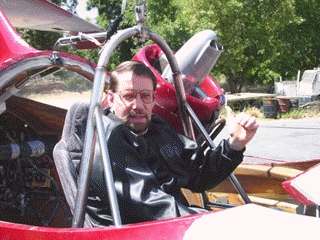|
|
Moller
International Inc. (MLER) |
|
|
CEOCFO CEOCFO Monthly Analyst |
"To print this page go to file and left click on print" Moller
International – introducing its Skycar® - a four-person Vertical Takeoff
and Landing (VTOL) aircraft Company Profile: CEOCFOinterviews:
Mr. Moller, how did Moller International get its start? Mr. Moller: “When I started this it was a side hobby; I was teaching at the University of California and building aircraft on the side as a follow up to some of the R&D that I was doing at the University. Eventually the R&D on the side became more real, and the prospect for it being a viable technology became more apparent then I left teaching and became an entrepreneur.” CEOCFOinterviews: Where are you now in the development of your business? Mr. Moller: “We have gone through many prototypes as you do in any technical product business. Along the line, I have formed other companies and created products, marketed them internationally and sold them - always with the goal in mind of creating a revolution in transportation in the air as opposed to the ground. It is an expensive activity because it requires very skilled people around you; we have spent over a million man-hours at this point and are approaching a couple hundred million dollars into this project. We are flying vehicles, which are very practical; the kind of vehicle that someone is going to use to get around as he does with his automobile. The issue is the needed infrastructure that is like having a car without the highway system. Even though highways are much easier to build in the air than they are on the ground, it still required a commitment to do that. Fortunately, the U.S. government has made that commitment and recently started putting into place those components to make it possible to have a highway in the sky.” CEOCFOinterviews: Who convinced the US Government and how? Mr. Moller: “I think they convinced themselves. The problem today is that the sky is disorganized, except for the highly controlled commercial airlines, where you are safe because they follow prescribed paths. But commercial flights aren’t very efficient because they don’t take you directly to where you really want to go, but they are a way to get over longer distances. However, smaller aircraft can fly to and from airports that are closer to your home and destination, but presently they are flown without the aid of flight controllers or sophisticated onboard systems and it is just a matter of operator skill keeping people from running into each other. It is recognized that much of the delay and cost is due to the use the inefficient routing of the “hub and spoke” system in use today by the commercial carriers and more and more travel by both small aircraft and commercial airlines will need to be directly from point A to point B to have a positive impact. They can do that only if they know where every vehicle is at all times with precise numbers and that is exactly what they are in the process of achieving now; it is going to be possible to know where every vehicle in the air is within a few feet at all times.” CEOCFOinterviews: Please tell us about the various products that you produce now, and is there revenue from what you do? Mr. Moller: “We have completed a number of contracts over the years for unmanned aerial vehicles (UAV), both for the military and civilian organizations. Right now, we have a contract from the California Department of Transportation to build a UAV for bridge inspection. Our UAV, called an Aerobot, takes off and lands vertically, and flies around with a small, user-defined payload. In this case we have a small video camera on-board. In addition, we have had a number of R&D contracts for applications of the rotary engine, including powering hybrid electric vehicles and use as a lightweight motor-generator set. Much of our money has come from private investors and businesses that I have created that have generated capital, which has gone back into this project.” CEOCFOinterviews: How many patents do you have and what is the technology? Mr. Moller: “There are three areas in which we hold patents including unmanned vehicles. With regard to the Skycar®, we have a number of generic patents. The Wright brothers patented a control system on the airplane, but they really didn’t patent the airplane even though many people may think so. We actually have a patent on our aircraft concept. The FAA had three aircraft categories: lighter than air, rotary wing, and fixed wing. They now have a fourth category of aircraft that is the one we are in called “powered lift aircraft”. This is a brand new category of aircraft and we have a fundamental patent on that type of aircraft. We also have fundamental patents on the engine that goes in that aircraft. One of the things that makes the Skycar possible is our rotary engine that works on the principles originally created by Felix Wankel, in Germany; we have been able to take that design and make it much smaller, more powerful while producing less emissions. They can be tucked away in the Skycar in a space you wouldn’t believe.” CEOCFOinterviews: What is it that’s different about your engine? Mr. Moller: “Rather than having pistons going up-and-down we have an engine where the motion is rotary. With a regular engine, there is wasted space under the piston and the crankcase and it means the engine gets quite large for the power it produces. The rotary engine is more like a turbine engine, in size but much less expensive. It is round and compact and most importantly, it can be tucked away in places that make it convenient and therefore you can use many of them. They only have two moving parts so you don’t have very many parts to fail. If one fails, the rest will continue to function and you won’t lose the aircraft. That is really key in this business; we have to produce a low-cost, safe vehicle to make it viable for the public.” CEOCFOinterviews: Is the Wankel engine used in other things as well? Mr. Moller: “It has almost been like a product waiting for a vehicle; it was used by Mazda in their rotary engine car, but it wasn’t that successful except in a sports car version because it is not an engine that does well when it sets there idling. Fortunately in an aircraft situation, you don’t idle very much. The Wankel engine has been around for a long time; it’s been used in a few snowmobiles, and a few outboard applications. For the most part, it has not found a large market, partly because, to make it efficient in an automobile, it becomes a very complicated engine even though it starts out simple. In the aircraft application, it is almost as if it was designed by providence to be exactly what you need? CEOCFOinterviews: You have many joint ventures and partnerships with what you are developing, why is that necessary? Mr. Moller: “We don’t see ourselves as necessarily major manufacturers even though we have been manufacturers; we are technology developers and, for political reasons, you need strategic partners to be dealing with government contracts. The government may give a company like ours contracts perhaps as large a couple of million dollars, however if you want a twenty or thirty million dollar contract; all of a sudden you have the attention of the Boeings and suddenly political clout supercedes technical merit. We are in a situation where the only way we are going to do serious business with the military is by having a strategic partner; we are working on that right now, knowing that the next goal is to get the right partner to build Skycars for the military.” CEOCFOinterviews: Has the impending military action and what has a happened in the last year or so increased interest in what you do? Mr. Moller: “Yes, I think it has even though surprisingly we had a very strong interest prior to this. We have seen strong interest from the army because they have this new goal of ‘breaking gravity”. That is a key phrase in the army right now, where the future army will have a strong airborne component. The Skycar® fits that so well that they have just formed an acronym just for the Skycar® called a “LAMV”, which stands for Light Aerial, Multi-purpose Vehicle. The Army sees this as a great logistics and a Medivac vehicle.” CEOCFOinterviews: Are there new technologies other than the engine that have an effect on what you do and that you are able to take advantage of? Mr. Moller: “Computer technology has been a great asset for us. The Skycar is what I describe as a ‘flying computer.’ Computation costs have gone down tremendously and since their processing power has gone up, the size of whatever you are using goes down. This is important because weight is so critical in a VTOL aircraft like the Skycar. Since cost is a major consideration, then the low-cost engine, electronic hardware, and the extreme capability of software to deal with all possible things that could go wrong, are very important for the Sky Car.” CEOCFOinterviews: How have you been doing with getting the attention of the investment community? Mr. Moller: “We are still a company that is struggling to get the attention of the investment community. This type of technology is considered very far out, and often in the minds of people who have been involved with aviation ventures it is an expensive technology to develop, which is certainly true. The only thing they don’t realize is that we have already covered a great deal of that expense and we have done it very efficiently. We are at a unique position right now, because we have a technology that still hasn’t generated serious competition. The only personal transportation solution that seems possible is an aviation solution. We have much evidence to support that - even the government is coming to that viewpoint. Our company is uniquely positioned to take advantage of this paradigm shifting change, however for the moment, the investment community has not fully grasped that possibility.” CEOCFOinterviews: What do you need to do to get the attention of investors? Mr.
Moller: “I think the only way we can do it is take advantage of the one thing
we have, and that is to focus on our attention-grabbing technology through demonstrating
it use. We have found that there are people
throughout the world; mostly outside the United States, that are enamored with the
potential of this technology perhaps that is why most of our larger investors are from
outside the United States. We will reach a greater level of credibility by serious and
expanded demonstrations. The danger is of course, that when you have limited capital, you
always worry about an accident that would not only jeopardize the reputation of the
company, and the product that would make it difficult to fund another vehicle. We are in
the process of trying to raising sufficient capital to go construct a number of vehicles
for our test program so that an expanded flight test program can take place.” disclaimers |


